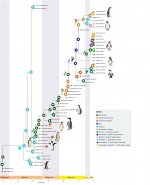albertonykus
Well-known member
Pelegrín, J.S. and C. Acosta Hospitaleche (2022)
Evolutionary and biogeographical history of penguins (Sphenisciformes): review of the dispersal patterns and adaptations in a geologic and paleoecological context
Diversity 14: 255
doi: 10.3390/d14040255
Despite its current low diversity, the penguin clade (Sphenisciformes) is one of the groups of birds with the most complete fossil record. Likewise, from the evolutionary point of view, it is an interesting group given the adaptations developed for marine life and the extreme climatic occupation capacity that some species have shown. In the present contribution, we reviewed and integrated all of the geographical and phylogenetic information available, together with an exhaustive and updated review of the fossil record, to establish and propose a biogeographic scenario that allows the spatial-temporal reconstruction of the evolutionary history of the Sphenisciformes, discussing our results and those obtained by other authors. This allowed us to understand how some abiotic processes are responsible for the patterns of diversity evidenced both in modern and past lineages. Thus, using the BioGeoBEARS methodology for biogeographic estimation, we were able to reconstruct the biogeographical patterns for the entire group based on the most complete Bayesian phylogeny of the total evidence. As a result, a New Zealand origin for the Sphenisciformes during the late Cretaceous and early Paleocene is indicated, with subsequent dispersal and expansion across Antarctica and southern South America. During the Eocene, there was a remarkable diversification of species and ecological niches in Antarctica, probably associated with the more temperate climatic conditions in the Southern Hemisphere. A wide morphological variability might have developed at the beginning of the Paleogene diversification. During the Oligocene, with the trends towards the freezing of Antarctica and the generalized cooling of the Neogene, there was a turnover that led to the survival (in New Zealand) of the ancestors of the crown Sphenisciform lineages. Later these expanded and diversified across the Southern Hemisphere, strongly linked to the climatic and oceanographic processes of the Miocene. Finally, it should be noted that the Antarctic recolonization and its hostile climatic conditions occurred in some modern lineages during the Pleistocene, possibly due to exaptations that made possible the repeated dispersion through cold waters during the Cenozoic, also allowing the necessary adaptations to live in the tundra during the glaciations.
Evolutionary and biogeographical history of penguins (Sphenisciformes): review of the dispersal patterns and adaptations in a geologic and paleoecological context
Diversity 14: 255
doi: 10.3390/d14040255
Despite its current low diversity, the penguin clade (Sphenisciformes) is one of the groups of birds with the most complete fossil record. Likewise, from the evolutionary point of view, it is an interesting group given the adaptations developed for marine life and the extreme climatic occupation capacity that some species have shown. In the present contribution, we reviewed and integrated all of the geographical and phylogenetic information available, together with an exhaustive and updated review of the fossil record, to establish and propose a biogeographic scenario that allows the spatial-temporal reconstruction of the evolutionary history of the Sphenisciformes, discussing our results and those obtained by other authors. This allowed us to understand how some abiotic processes are responsible for the patterns of diversity evidenced both in modern and past lineages. Thus, using the BioGeoBEARS methodology for biogeographic estimation, we were able to reconstruct the biogeographical patterns for the entire group based on the most complete Bayesian phylogeny of the total evidence. As a result, a New Zealand origin for the Sphenisciformes during the late Cretaceous and early Paleocene is indicated, with subsequent dispersal and expansion across Antarctica and southern South America. During the Eocene, there was a remarkable diversification of species and ecological niches in Antarctica, probably associated with the more temperate climatic conditions in the Southern Hemisphere. A wide morphological variability might have developed at the beginning of the Paleogene diversification. During the Oligocene, with the trends towards the freezing of Antarctica and the generalized cooling of the Neogene, there was a turnover that led to the survival (in New Zealand) of the ancestors of the crown Sphenisciform lineages. Later these expanded and diversified across the Southern Hemisphere, strongly linked to the climatic and oceanographic processes of the Miocene. Finally, it should be noted that the Antarctic recolonization and its hostile climatic conditions occurred in some modern lineages during the Pleistocene, possibly due to exaptations that made possible the repeated dispersion through cold waters during the Cenozoic, also allowing the necessary adaptations to live in the tundra during the glaciations.





